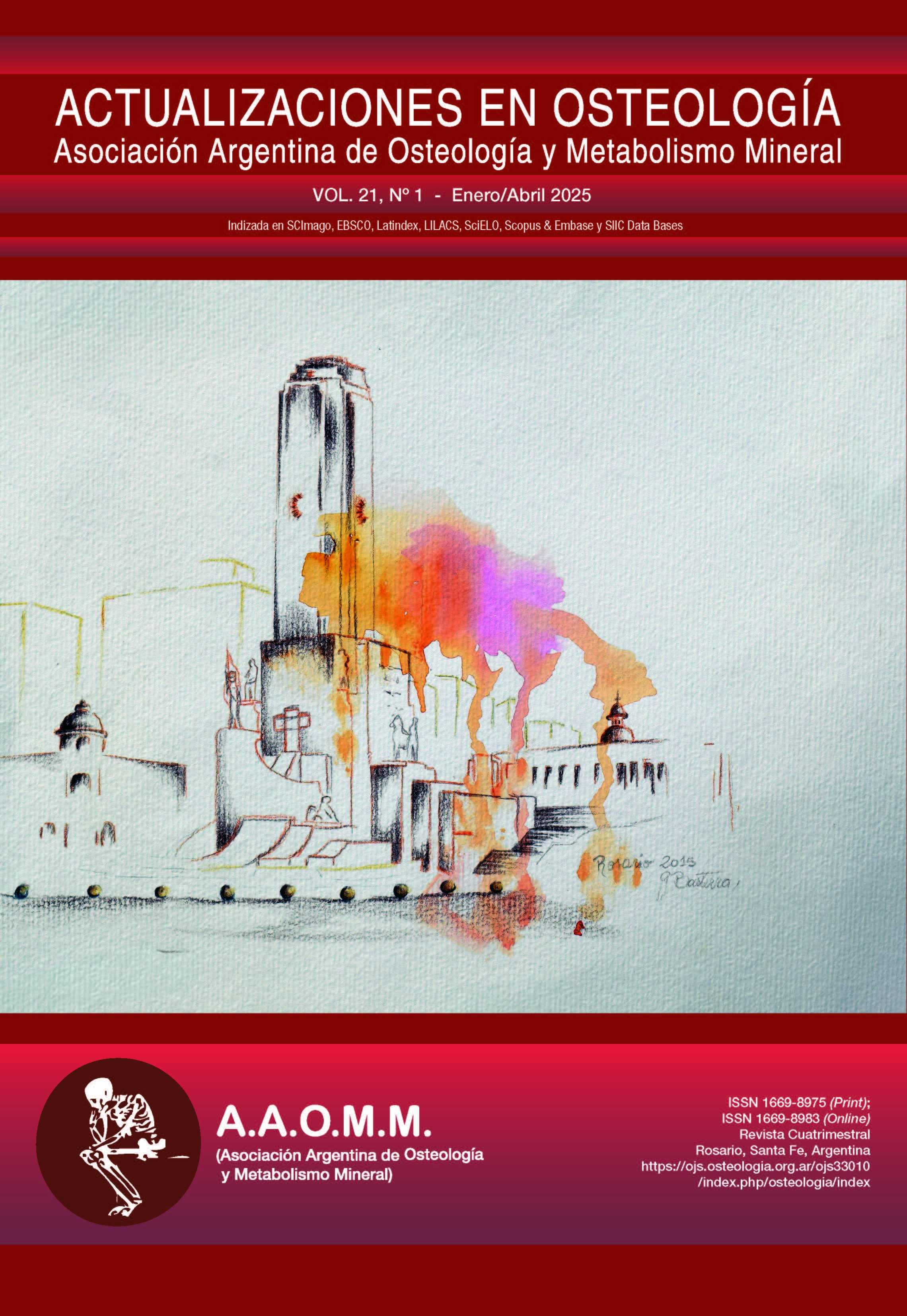Association Between Preexisting Medical Conditions and Sites of Fragility Fractures: An Analytical Study
Main Article Content
Abstract
ABSTRACTIntroduction: medical history increases the risk of fragility fractures, predisposing to more vulnerable areas according to the type of history.
Objective: to determine the most vulnerable areas of fragility fractures according to clinical history.
Materials and method: analytical and cross-sectional study of a secondary database of 719 adults. The variables were the presence of shoulder, wrist, hip and ankle fractures, age, sex, diabetes mellitus, hypertension, obesity, smoking, reduced mobility, dyslipidemia, osteoporosis, age, arthritis, renal, cardiovascular and thyroid disease, cancer and number of comorbidities. The automatic detection tree of chi-square interactions and Cramer's V were used.
Results: the decision tree identified key variables of fragility fracture areas, age group, diabetes and comorbidities. Ankle fractures were associated primarily with individuals aged 50 to 65 years with diabetes (V=0.181; p<0.001). Hip fractures with individuals aged 84 years or older (V=0.332; p<0.001). Shoulder and wrist fractures with individuals aged 66 to 83 years with two or fewer comorbidities (V=0.216; p<0.001).
Conclusions: fragility fractures are significantly associated with age and the presence of comorbidities, especially diabetes. People older than 84 years have a greater propensity for hip fractures, those between 50 and 65 years with diabetes are more prone to ankle fractures. Shoulder and wrist fractures are more common in individuals aged 66 to 83 years with few comorbidities.
Article Details
Derechos de autor: Actualizaciones en Osteología es la revista oficial de la Asociación Argentina de Osteología y Metabolismo Mineral (AAOMM) que posee los derechos de autor de todo el material publicado en dicha revista.
References
Porter JL, Varacallo M. Osteoporosis. En: StatPearls [Internet]. Treasure Island (FL): StatPearls Publishing; 2024. Disponible en: https://www.ncbi.nlm.nih.gov/pubmed/28722930
Brickley MB, Ives R, Mays S. Secondary osteoporosis. En: The Bioarchaeology of Metabolic Bone Disease [Internet]. Elsevier; 2020. p. 165–78. Disponible en: http://dx.doi.org/10.1016/b978-0-08-101020-4.00007-0
Sobh MM, Abdalbary M, Elnagar S, Nagy E, Elshabrawy N, Abdelsalam M, et al. Secondary osteoporosis and metabolic bone diseases. J Clin Med [Internet]. 2022;11(9):2382. Disponible en: http://dx.doi.org/10.3390/jcm11092382
Xiao P-L, Cui A-Y, Hsu C-J, et al. Global, regional prevalence, and risk factors of osteoporosis according to the World Health Organization diagnostic criteria: a systematic review and meta-analysis. Osteoporos Int [Internet]. 2022;33(10):2137–53. Disponible en: http://dx.doi.org/10.1007/s00198-022-06454-3
Redman IA, Sivanesan V. A five-year retrospective audit on bone protection prescribing in patients with fragility fractures in primary care. Cureus [Internet]. 2023;15(9):e45532. Disponible en: http://dx.doi.org/10.7759/cureus.45532
Bouvard B, Annweiler C, Legrand E. Osteoporosis in older adults. Joint Bone Spine [Internet]. 2021;88(3):105135. Disponible en: http://dx.doi.org/10.1016/j.jbspin.2021.105135
Zigouris A, Theodorou S, Zisakis A, Labropoulos C. A Comprehensive Review of Hip Arthroscopy: Current Trends and Future Directions. In: Pokorski M, editor. Current Concepts in Medical Research and Practice. Cham: Springer; 2024. p. 13-26. doi:10.1007/978-3-031-33484-9_2
Fragility fractures [Internet]. Who.int. [citado 12 de noviembre de 2024]. Disponible en: https://www.who.int/news-room/fact-sheets/detail/fragility-fractures
Torres-Reveron A, Serra-Torres M. Retrospective analysis of the use of osteoporosis medication at the presentation of non-vertebral fragility fractures in a predominantly Hispanic population. F1000Res [Internet]. 2021 [citado 13 de noviembre de 2024];10(175):175. Disponible en: https://f1000research.com/articles/10-175/pdf
Ortega C. Análisis CHAID: Qué es, características y cómo se realiza [Internet]. QuestionPro 2022 [citado 13 de noviembre de 2024]. Disponible en: https://www.questionpro.com/blog/es/analisis-chaid/
SPSS statistics subscription - classic [Internet]. Ibm.com. 2024 [citado 13 de noviembre de 2024]. Disponible en: https://www.ibm.com/docs/es/spss-statistics/saas?topic=crosstabs-statistics
Veronese N, Kolk H, Maggi S. Epidemiology of fragility fractures and social impact. En: Practical Issues in Geriatrics [Internet]. Cham: Springer International Publishing; 2021 [citado 13 de noviembre de 2024]. p. 19–34. Disponible en: https://www.ncbi.nlm.nih.gov/books/NBK565577/
Cheng C-H, Chen L-R, Chen K-H. Osteoporosis due to hormone imbalance: An overview of the effects of estrogen deficiency and glucocorticoid overuse on bone turnover. Int J Mol Sci [Internet]. 2022;23(3):1376. Disponible en: http://dx.doi.org/10.3390/ijms23031376
Gouveri E. Charcot osteoarthropathy in diabetes: A brief review with an emphasis on clinical practice. World J Diabetes [Internet] 2011;2(5):59. Disponible en: http://dx.doi.org/10.4239/wjd.v2.i5.59
Sarasa-Roca M, Torres-Campos A, Redondo-Trasobares B y cols. Fractura de cadera en pacientes centenarios, ¿qué podemos esperar? Rev Esp Cir Ortop Traumatol [Internet]. 2022;66(4):267-73. Disponible en: http://dx.doi.org/10.1016/j.recot.2021.04.004
Pech-Ciau BA, Lima-Martínez EA, Espinosa-Cruz GA y cols. Fractura de cadera en el adulto mayor: epidemiología y costos de la atención. Acta Ortop Mex [Internet]. 2021;35(4):341-7. Disponible en: http://dx.doi.org/10.35366/103314

